The Incomplete Wolverine – 1991
Part 1: Origin to Origin II | Part 2: 1907 to 1914
Part 3: 1914 to 1939 | Part 4: World War II
Part 5: The postwar era | Part 6: Team X
Part 7: Post Team X | Part 8: Weapon X
Part 9: Department H | Part 10: The Silver Age
1974-1975 | 1976 | 1977 | 1978 | 1979
1980 | 1981 | 1982 | 1983 | 1984 | 1985
1986 | 1987 | 1988 | 1989 | 1990
We’re now firmly into the 90s, and the Larry Hama run is just getting underway. For those who skipped the previous chapter, the tail end of Chris Claremont’s Uncanny X-Men run is in there (even though it came out in 1991), because the reading order makes more sense that way. All of that is going on alongside the comics we’re about to look at. Does skipping Uncanny X-Men leave us with a quiet 1991? No, of course it doesn’t…
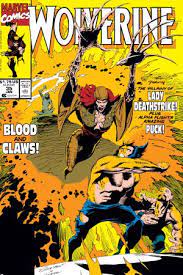 WOLVERINE vol 2 #35-37
WOLVERINE vol 2 #35-37
“Blood & Claws”
by Larry Hama, Marc Silvestri, Dan Green, Glynis Oliver & Mark Chiarello
January to March 1991
Lady Deathstrike is back on her revenge kick. Figuring that Gateway is always trying to frustrate the Reavers by looking for loopholes in their instructions, she tells him to send her to “the place that Wolverine gazes upon this very moment.” Of course, this instruction contains a loophole: Logan and Puck are reminiscing over photographs of Puck’s time fighting in the Spanish Civil War. And so Gateway sends all three of them back to 1937, where Logan and Puck hook up with the partisans that Puck fought alongside back in the day. Hama continues to set the tone for his take on Wolverine by having the group include Ernest Hemingway and “Ricky Blair” (i.e. George Orwell) – this Logan is hyper-masculine, but smarter than he first seems, even if he plays that side of himself down. Hama even has him observe that in war, everyone misses everyone else when humanly possible – in reality, a quotation from Orwell’s Homage to Catalonia (1938).
Meanwhile, Deathstrike hooks up with Nazis to pursue our heroes, and mulls over trying to change her father’s history, so that she never ends up with a duty to avenge him. When she finally catches up, Hama restates Claremont’s take on her: she’s given up her humanity because of an obsession over his adamantium, when Wolverine would much prefer to be rid of the whole thing. The fight ends inconclusively when Deathstrike kills a German soldier who was meant to survive the war, creating a time vortex that sends everyone home. In a subplot, this alteration of history causes a distraction that leads to Donald Pierce’s new robot, Elsie-Dee, accidentally getting genius level intelligence. But we’ll get to that.
This story treats Wolverine and Puck as old friends. That contradicts Alpha Flight vol 1 #16-17, where they meet for the first time. It’s also Lady Deathstrike’s first appearance in the Wolverine solo title, presumably because she’s been viewed principally as one of the Reavers in the last couple of years. The story completely ignores the conventional Marvel Universe time travel rules of the period, whereby all time travel creates a divergent reality. But Claremont always seemed to write X-Men on a completely different premise, that time could be altered – the end of the Kulan Gath storyline, where Nimrod cancels out the whole thing, is a particularly obvious case, which the Official Handbook struggles to explain away. Hama is really just following the established rules of the X-Men over the rules of the wider Marvel Universe.
MARVEL TEAM-UP vol 3 #19
“1991”
by Robert Kirkman, Cory Walker, Cliff Rathburn & Bill Crabtree
April 2006
Wolverine and Jubilee try to retrieve a Cosmic Cube fragment from HYDRA. The Mandarin also shows up looking for it, and Cable appears to prevent the timeline from being screwed up by Wolverine’s death. Wolverine grudgingly accepts Cable’s help, but the Mandarin escapes with the fragment.
This is a flashback story setting up the “Freedom Ring” arc that follows – and which doesn’t concern us at all.
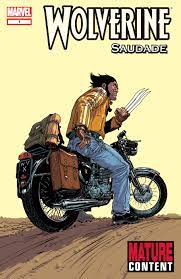 Flashbacks in WOLVERINE: SAUDADE
Flashbacks in WOLVERINE: SAUDADE
by Jean-David Morvan & Philippe Bouchet
November 2008
Logan interrupts his Brazilian holiday to investigate a new mutant detected by Cerebro. He finds two: psionic street kid Andre Mexer and cult leader Kuhrra Daizonest. Daizonest uses his powers to pose as a faith healer, while apparently feeding on his patients. Logan rescues Mexer from Daizonest, who dies in battle. But the experience leaves Mexer’s mind burned out.
There’s a brief framing sequence in which Morrison-era Wolverine tells the story to some of the X-Men’s students, and which establishes that Mexer is eventually taken on by the X-Men as a caretaker. To be fair, there’s a suggestion that Logan is glossing over the less pleasant details; presumably Mexer was only transferred to the school after it became a full-blown institution and needed some regular staff. The hook of the story is meant to be that Mexer could have been a significant character if only Logan had got to him slightly sooner.
Saudade is an unusual comic – it’s a translated reprint of a French licensed story, but it is officially canon for the mainstream Marvel Universe. It’s very pretty, and also unusually bloody for the time.
AVENGERS vol 1 #332-333
“The Many Faces of Doom” / “Life of the Party”
#332 by Larry Hama, Paul Ryan, Tom Palmer & Christie Scheele
#333 by Larry Hama, Herb Trimpe, Tom Morgan, Reggie Jones & Christie Scheele
May and June 1991
Wolverine is one of a horde of guest stars attending the opening of the new Avengers HQ. Dr Doom gatecrashes and the Avengers deal with him while everyone else stands around cameoing. This seems to be the first place where Wolverine meets Sersi of the Eternals, the Falcon (Sam Wilson), Quasar (Wendell Vaughan) and Rage (Elvin Halliday).
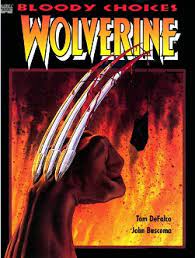 WOLVERINE: BLOODY CHOICES
WOLVERINE: BLOODY CHOICES
by Tom DeFalco, John Buscema & Gregory Wright
June 1991
While on holiday in Hawaii (yes, I know he’s only just been on holiday, but he’s got a nice long interval between X-Men stories here, so give him a break), Logan crosses paths with Mr Bullfinch. Bullfinch is running a paedophile ring and kidnapping small boys, but he’s also providing information against a major drug ring, and so an unenthusiastic Nick Fury has to defend him for the greater good. Fury does actually try, but Wolverine gets past him and, by all appearances, kills Bullfinch.
The art on this is excellent, and yet it still manages to be an all-time dud. It clearly believes that it’s a serious work, but it doesn’t have the depth or sensitivity to get away with invoking child abuse, and it never seems to genuinely believe that there’s any moral dilemma involved. What’s more, to say that Tom DeFalco botches Wolverine’s narration would be an understatement: “But now, bereft of sight and smell, I am trapped within a cocoon of total darkness, and compassion is an extravagance that I can no longer afford!” A bizarre subplot involves Bullfinch’s henchman Shiv, who has Wolverine’s hairstyle, uses a blade weapon strapped to his wrist, and is at first implied to be Wolverine’s brother. But ultimately Wolverine’s “animal instinct” tells him that they’re “merely two men who share certain physical characteristics – and a similarity of lifestyle.”
DeFalco will write some perfectly acceptable fill-in issues of Wolverine in a few years time, but this is awful.
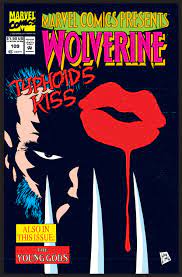 MARVEL COMICS PRESENTS vol 1 #109-112
MARVEL COMICS PRESENTS vol 1 #109-112
“Typhoid’s Kiss”
by Ann Nocenti, Steve Lightle & Kelly Corvese
August to November 1992
Continuing his attempt to get away from it all, Logan is staying in a motel when he encounters Roberts, a paranoid schizophrenic and serial killer who believes that government experiments broke his mind, and wants revenge. In between incoherent attempts to kill Logan, Roberts manages to send him to Mary Walker. Mary also has hazy memories of being a brainwashed spy. There’s a definite implication that she and Logan sleep together during this story. Eventually, Logan discovers that Mary is one of the multiple personalities of Typhoid. With the information they uncovered together, Typhoid sets out on a revenge spree against the scientists involved in the brainwashing experiments, and Logan has to try and stop both her and Roberts. Along the way, we establish that the experiments were part of the CIA’s MK-Ultra programme (which is a real thing).
By the time Wolverine catches up with Typhoid, she’s reverted to her Mary persona and reached MK-Ultra head Dr Sid Joern (a blatant stand-in for the real-life Sidney Gottlich). She asks him to remove the Typhoid persona, but he actually plans to kill her because she knows too much. Wolverine rescues Mary, and she escapes as Typhoid. Wolverine turns to kill Sid, who confidently insists that Wolverine himself has been mind-altered by MK-Ultra and won’t be able to do it. The story ends there. But since Sid shows up in a later Typhoid story as a severed head on life support, apparently his confidence was misplaced.
This is one of several Typhoid stories that Ann Nocenti wrote for the notoriously inconsistent anthology title Marvel Comics Presents. It’s placed here, a year out of publication order, because it expressly takes place before Daredevil #296 (cover date September 1991). It’s staggeringly dense, but certainly interesting. The high concept of Typhoid (at least in Nocenti’s MCP stories) is that each of her personalities is defined by how she relates to men – Mary defers to men and looks to them for protection, which Wolverine treats as relatively normal, if slightly drippy, behaviour. Typhoid tries to use men, which Wolverine recognises and rejects. We’ll come back to this theme in future Typhoid MCP stories, where Wolverine also appears.
Nocenti has some unusual ideas about Wolverine. He’s dismissive about animal rights protestors, and seems entirely comfortable with animal testing on the grounds that everyone has some blood on their hands. He claims that he never kills, which seems to be intended as a suggestion that his MK-Ultra programming inhibits him – but it can be read as him telling Mary what she wants to hear. The basic joke of using Wolverine in this story is that Roberts is spouting classic tin-foil-hat conspiracy theories about the CIA, and that Wolverine’s back story is essentially the same thing but with superhero trappings.
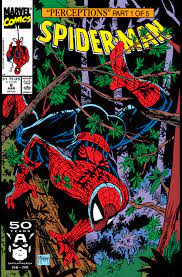 SPIDER-MAN vol 1 #8-12
SPIDER-MAN vol 1 #8-12
“Perceptions”
by Todd McFarlane & Gregory Wright
March to July 1991
When two small boys in Hope, British Columbia, are seemingly killed by a sasquatch-like creature, a media frenzy follows, and paranoid locals start hunting innocent animals. Wolverine shows up to put a stop to it, and winds up teaming with Spider-Man, who has come to town as a photojournalist. The heroes expose the truth: the Wendigo is innocent, and the actual killer is a local police officer, Krahn.
This isn’t great, but it’s better than its reputation might suggest. It’s far too long and the writing is a bit clumsy, but the central story idea is perfectly solid, and Wolverine’s appearance isn’t gratuitous: he’s serving as the rural, outsider counterpoint to Spider-Man’s media-insider view. That said, McFarlane writes Wolverine as an obsessive anti-hunter here, and while that has some basis in past stories, his usual objection is to people hunting purely for sport. The locals here are hunting out of self-defence, albeit in a rather excessive way, which is something Wolverine ought to have a bit more sympathy for.
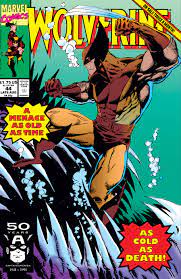 Flashbacks in WOLVERINE vol 2 #44
Flashbacks in WOLVERINE vol 2 #44
“Babes at Sea”
by Peter David, Larry Stroman, Al Milgrom & Steve Buccellato
Late August 1991
This is a fill-in story told as a flashback with a token framing sequence. There are quite a few fill-in stories coming up over the next year or so, several of which appear in the middle of lengthy storylines, and have to be placed out of publication order.
After having recurring nightmares about a baby on a cruise ship (which is identifiable by its registry number), Logan books himself onto a cruise in order to investigate. One of the passengers is pregnant with a psychic baby who is being hunted a mysterious monster, as part of some ancient eternal cycle; the baby has been calling for help. The monster kills two other pregnant passengers before Wolverine kills it in turn. The mystery doesn’t really pay off, and it’s not one of Peter David’s best.
 WOLVERINE vol 2 #38-42
WOLVERINE vol 2 #38-42
“See Venice & Die!” / “RDeconstruction” / “DReconstuction” / “Down in the Bottoms” / “Papa was a Rolling Stone!”
by Larry Hama, Marc Silvestri, Dan Green & Glynis Oliver
April to July 1991
Back to Larry Hama, and some more central elements from his run.
Donald Pierce has built two robots as part of his latest plan to kill Wolverine. Albert is a robot duplicate of Wolverine who is meant to cause trouble in the LA underworld and lure Wolverine to investigate. Once he’s there, Elsie-Dee will pretend to be a little girl in danger, so that Wolverine will come to her rescue and she can blow herself up. Back in 1991, death by explosion was still being portrayed as a realistic risk for Logan. Logan duly shows up in Los Angeles, and encounters dimwit thugs Molokai, Reno, Jocko and Sally (who will eventually get patched into Jubilee’s back story).
Logan does indeed fight Albert, and causes him some damage (which gets patched up but never fully repaired). Elsie tries to put her part of the plan into operation. But unfortunately for Pierce, Elsie was accidentally given genius-level AI back in issue #37, and she’s so impressed by Wolverine’s heroism that she rebels. She tries to resist her programming long enough for Wolverine to escape before the bomb goes off, but he heroically refuses to abandon her, insisting that she’s proven her humanity by offering to sacrifice herself. So instead she gets Albert to hack the NSA computers in order to figure out how to shut off her bomb. This is 1991, so we get a scene of him breaking into Radio Hut to steal a modem. Albert does indeed manage to transmit the disarm code to Elsie, but gets gunned down by the police seconds later.
There’s a weird running joke here with two bikini-clad girls called Bunny and Cyndi, who are one-note stereotypes and are instantly smitten with Logan. This hasn’t aged well, but Hama is clearly pitching Logan as a charismatic, highly appealing man, not just to the readers, but to those around him.
Continuing the story, Logan takes Elsie-Dee back to the X-Men Mansion, where Forge points out that she’s still a walking bomb and that there’s no apparent way of removing the explosives. Albert shows up in a stolen stealth bomber, looking for her; they wind up getting shot down and crashing into the East River. Albert is lost again, but Elsie-Dee and Logan escape, leading to a sequence in the Morlock tunnels. Sabretooth, who has been lying around down there since New Mutants #91, attacks Wolverine on sight. During the fight, Sabretooth claims to be Wolverine’s father, kicking off Hama’s memory implant storyline. When a flash flood hits the tunnels, Elsie separates her head from her body and blows herself up to clear a path out. (Elsie says this will kill her because she has very low power reserves in her head; quite why Forge couldn’t have rigged up a power source for her at the Mansion is anyone’s guess.) Again, we get a bit about Elsie’s heroic sacrifice before she disappears off into the water with Sabretooth.
Oh, and Cable shows up as a guest star towards the end. He doesn’t add a great deal, but he and Wolverine are clearly rivals. Cable is even unwilling to risk his life to help Wolverine – admittedly in a situation where it would have been very risky to do so – and makes it very clear that this is about their past relationship. Like other early hints about a Wolverine / Cable rivalry, this never really goes anywhere.
Jubilee also starts tagging along with Wolverine in the second half of this story; from here on she effectively functions as his sidekick.
At the end of the story, Nick Fury tells Wolverine that Sabretooth is not his father, but he really does believe himself to be. He refuses to explain further, since it’s top secret. That, of course, sets up the main plot for the next year.
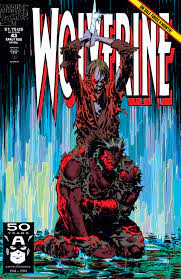 WOLVERINE vol 2 #43
WOLVERINE vol 2 #43
“Under the Skin”
by Larry Hama, Marc Silvestri, Dan Green & Steve Buccellato
Early August 1991
This takes place immediately after the previous arc, but it’s unrelated. Logan encounters Linus, who has killed and replaced the overnight cleaner at Central Park Zoo, and started torturing the animals. Completely unsympathetic to Linus’s very obvious mental health issues, Logan releases the zoo’s wolverine, and Linus flees with the little creature in pursuit. We’ll see Linus again in issue #90.
This leads directly into the framing sequence in Wolverine #44, in which Logan decides to have a sit down and reminisce about that cruise ship thing.
DAMAGE CONTROL vol 3 #4
“Cleanliness is Next to Godliness”
by Dwayne McDuffie, Ernie Colón & Brad Vancata
September 1991
The cosmic-powered Edifice Rex (Rex Randolph) plans to destroy the universe in order to make it neater, but Damage Control talk him out of it. Wolverine is among a large number of superheroes who show up to deal with Edifice Rex but never get to do anything.
It’s a joke cameo, but it is a mass meeting of heroes, and so it adds a few more names to the list of people Wolverine has met. Aside from Damage Control’s John Porter, this seems to be his first meeting with Andromeda, Her, SHIELD agent Alexander Pierce and the New Warriors – (Speedball (Robbie Baldwin), Nova (Richard Rider), Night Thrasher (Dwayne Taylor), Namorita, Marvel Boy (Vance Astrovik) and Silhouette (Silhouette Chord)). Yes, it took Wolverine this long to meet Nova.
X-MEN: TRUE FRIENDS #3
“Claiming the Crown”
by Chris Claremont, Rick Leonardi, Al Williamson, Jimmy Palmiotti & Shannon Blanchard
November 1999
This time-travel series features a 1930s Logan prominently, but we covered that a while back. The present-day Logan appears briefly in the epilogue, at a guest at a reception in Edinburgh for the opening of the Scottish Parliament. At the time of publication this was a bit odd, since the story expressly took place in the past – in fact, it was a half-finished project from the early 1990s, which is likely why Marvel’s official timelines place it here. In 1999 this wouldn’t have made sense – the Scottish Parliament was only voted into being in 1998, was a new institution in 1999, and didn’t even have a completed building until 2004. Fortunately, this is a rare case where sliding time has actually fixed a continuity problem rather than creating one.
Oh, and Logan meets Excalibur supporting character Alysande Stuart here.
 WOLVERINE vol 2 #45-46
WOLVERINE vol 2 #45-46
“Claws Over Times Square” / “Home is the Hunter…”
by Larry Hama, Marc Silvestri, Dan Green & Steve Buccellato
September 1991
Casino owner Ronald Parvenue has captured the Hunter in Darkness (from issue #34), and brings it to New York as a tourist attraction. Jubilee is worried that Logan will do something stupid, and reminds Wolverine that Parvenue has done nothing illegal. Wolverine says he has nothing in particular in mind. “There’s just something wild inside me pulling at me to do things I don’t understand.”
When the Hunter is unveiled, Sergeant Doolin’s daughter Emmy Doolin tries to kill it with a sniper rifle, in an attempt to avenge her father. She hasn’t been able to find out the truth about his death because everything to do with Wolverine is classified, and so she wrongly blames the Hunter. Also showing up for the chaos are Lady Deathstrike (allied with Parvenue), and Sabretooth (who correctly guessed that Wolverine would show up). This leads to a four-way fight between Wolverine, Deathstrike, Sabretooth and the Hunter, with Jubilee fretting from the sidelines and Emmy trying to get a clean shot.
Naturally, she winds up shooting everyone else with her mercury-tipped bullets, which prompts both Wolverine and Sabretooth to start hallucinating. Wolverine gets the same images of trees and spikes that he hallucinated during Barry Windsor-Smith’s “Weapon X” arc. This is as good a time as any to flag that, although we’re not covering it in this post (because it’s a flashback story), “Weapon X” also came out in 1991; the new interest in Wolverine’s back story feeds through into both Wolverine and the first year or so of X-Men vol 2.
Sabretooth, meanwhile, has the same hallucinations as Wolverine. He starts calling Wolverine his “partner” and proposes an alliance to escape “the Project” together – and then denies being Wolverine’s father after all, blaming that on programming. Wolverine comes to his senses when Jubilee is endangered, and Emmy is soon defeated. Sabretooth and Deathstrike escape, and Wolverine is left wondering what Sabretooth’s hallucinations reveal about their shared past.
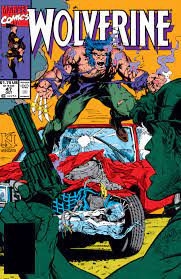 WOLVERINE vol 2 #47
WOLVERINE vol 2 #47
“Dog Day”
by Larry Hama, Gerald DeCaire, Don Hudson & Glynis Oliver
October 1991
Logan encounters drug addict Tracey, who has just committed a hit and run. Mistaking Logan for a cop, Tracey tries to run him over. All this brings to mind the time when Logan couldn’t bring himself to put down Silver Fox’s rabid dog, and she ended up doing it herself, even though there was no alternative and the dog really wanted to be put out of its misery. That’s…. gosh, that’s quite the analogy, isn’t it? Anyway, Logan never gets past pondering these parallels, because as soon as Tracey starts shooting at him, he’s promptly gunned down by a real cop.
NICK FURY, AGENT OF SHIELD vol 3 #25-29
“Commencement Ceremonies” / “Graduation Day” / “Recruitment Drive” / “Icy Roads” / “The Cold War”
#25 by DG Chichester, Jackson Guice, Doug Hazelwood & Steve Buccellato
#26 by DG Chichester, Jackson Guice, Doug Hazelwood & Nel Yomtov
#27-28 by DG Chichester, Ernie Stiner, Don Hudson & Steve Buccellato
#29 by DG Chichester, Ernie Stiner, Don Hudson & Tom Vincent
July to November 1991
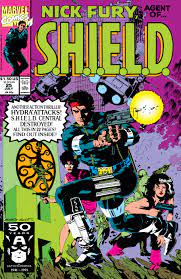 With HYDRA blackmail depriving the newly-relaunched SHIELD of funds, Nick Fury ropes in Wolverine to help his small team go after a HYDRA base in the Arctic. Aside from Dugan and Pierce, Wolverine also meets SHIELD agents Kate Neville and Network Nina. Much of the plot involves an obsessive Fury refusing to properly explain his crazy plans to his teammates, and Wolverine yelling at him for it. The heroes also fight HYDRA lieutenants Guillotine (Nicos Pelletier), Erik Saltz, Garotte (Tyrannus Cordin) and Cassandra Romulus (no relation). HYDRA escape after their plan to recover an abandoned nuclear-powered icebreaker is thwarted, but Guillotine dies in battle trying to prove himself.
With HYDRA blackmail depriving the newly-relaunched SHIELD of funds, Nick Fury ropes in Wolverine to help his small team go after a HYDRA base in the Arctic. Aside from Dugan and Pierce, Wolverine also meets SHIELD agents Kate Neville and Network Nina. Much of the plot involves an obsessive Fury refusing to properly explain his crazy plans to his teammates, and Wolverine yelling at him for it. The heroes also fight HYDRA lieutenants Guillotine (Nicos Pelletier), Erik Saltz, Garotte (Tyrannus Cordin) and Cassandra Romulus (no relation). HYDRA escape after their plan to recover an abandoned nuclear-powered icebreaker is thwarted, but Guillotine dies in battle trying to prove himself.
This is a classic example of a completely gratuitous Wolverine appearance. He doesn’t need to be in this arc at all, let alone in five issues of it. Notionally, his role here is to be the outsider who isn’t overawed by Fury’s reputation and will call him on things that his rookie squad will let slide. But Dugan could have done that, and it would have been a better story if he had.
INFINITY GAUNTLET #2-4
“From Bad to Worse” / “Preparations for War” / “Cosmic Battle on the Edge of the Universe”
#2-3 by Jim Starlin, George Pérez, Josef Rubinstein & Max Scheele
#4 by Jim Starlin, Ron Lim, George Pérez & various
August to October 1991
Wolverine is among the superheroes who answer the call to fight Thanos, newly empowered by the almighty Infinity Gauntlet. Wolverine gets the obligatory moment where he’s the one hero willing to go for the killing blow, but of course he fails, and the story otherwise plays out without him having much input. He meets Adam Warlock and his sidekick Pip the Troll here, along with an emaciated Nebula, Thanos’s puppet girlfriend Terraxia and the stand-in Thor (Eric Masterson). For ultra-completists, Wolverine also has one-panel cameos in Silver Surfer vol 3 #52 and Doctor Strange, Sorcerer Supreme #33, but those are just alternate versions of scenes from Infinity Gauntlet itself.
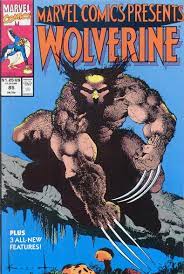 MARVEL COMICS PRESENTS vol 1 #85-92
MARVEL COMICS PRESENTS vol 1 #85-92
“Blood Hungry”
by Peter David, Sam Kieth & Glynis Oliver
September to December 1991
This is the debut of Cyber, who goes on to become a recurring villain in the 90s – and thus it’s one of the handful of Marvel Comics Presents Wolverine stories to have lasting effects. That said, the story itself is pretty unimportant, and Wolverine and Cyber have clearly met before (under those names).
Cyber is in Madripoor to do a drug deal with the Prince. Wolverine claims to be delighted to have the chance for another go against Cyber, but gets quickly disembowelled, and has to retreat into the woods. Since Cyber’s claws are laced with a powerful hallucinogen, Wolverine recalls his history with Cyber, but in a garbled, confused fashion filtered through movie tropes and so forth. Broadly speaking, these flashbacks suggest that Cyber was once Wolverine’s teacher, that they came into conflict over a woman, who was killed in the ensuing fight. Wolverine is psychologically scarred by the experience, and terrified of fighting Cyber again. (Wolverine: Origins eventually gives the prosaic version of these events, and folds them into its conspiracy theory whereby Romulus had all Wolverine’s love interests killed.) Tyger Tiger encourages Wolverine to face Cyber again, and Wolverine defeats him by going for his exposed face. A wolf from earlier in the story then makes Cyber fall into a vat of hallucinogens, before vanishing – there’s a suggestion that it’s some sort of projection of Wolverine’s spirit, which doesn’t entirely make sense.
Extraordinarily odd, and only partially explained away by the Origins version, since this story seems to suggest that Wolverine has met Cyber before as Cyber. Still, it was always nice to see MCP producing material as weird as this.
MARVEL COMICS PRESENTS vol 1 #89
“What’s Wrong With This Picture?!”
by Dan Slott, Joe Madureira, Christopher Ivy & Fred Mendez
November 1991
Mojo tries to make a documentary about the X-Men, inadvertently films his own face for the entire time, and somehow has a hit anyway.
MARVEL #5
“Wolverine”
by Mark Waid & Lucio Parrillo
February 2021
Professor X and Cyclops discuss Wolverine’s approach to combat while watching him fight the Hulk. That’s it. It’s just a stating-the-premise vignette. Placed here solely on the basis of the costumes: Wolverine’s in brown, Cyclops is in his 90s X-Men outfit, Professor X is in a normal wheelchair.
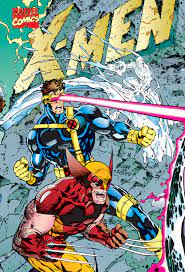 X-MEN vol 2 #1-3
X-MEN vol 2 #1-3
by Chris Claremont, Jim Lee, Scott Williams & Joe Rosas
“Rubicon” / “Firestorm” / “Fallout!”
October to December 1991
We’ve finally caught back up with the X-Men’s stories. This story is a coda to the Claremont run, and the start of the short lived period of the Image founders. The reset button has been hit in a big way, and the X-Men (now including all the founding members) are back together, living in a rebuilt Mansion. Because there are now two ongoing X-Men titles with different creative teams, there are also now two teams: the Blue Team (Cyclops, Beast, Wolverine, Gambit, Psylocke and Rogue) and the Gold Team (Storm, Jean Grey, Archangel, Iceman and Colossus). Increasingly, though, the focus of Wolverine’s stories is going to be in his solo book, so we’re going to see quite a few X-Men stories in which he’s simply making up the numbers and generally helping the book to look familiar.
Magneto is now living in Asteroid M, and returns to villainy at the prompting of a group of Acolytes – Fabian Cortez, Marco Delgado, Chrome (Allen Yuric), Nance Winters and Anne-Marie Cortez. In fact, initially it’s more that Magneto sets himself up as a refuge for mutants, but Fabian is manipulating Magneto into conflict, while giving him power boosts that slowly poison him. Fabian tells Magneto (correctly) that Moira MacTaggert tried to alter his personality during the period when he was reduced to infancy. He vengefully forces Moira to use the same technique to brainwash the Blue Team, but the Gold Team come to the rescue, and the brainwashing soon wears off anyway, because it turns out that it doesn’t actually work. Cortez flees and tries to destroy the station; the X-Men escape; Magneto and the other Acolytes remain aboard Asteroid M as it crashes. (Don’t worry – Magneto will be fine, and the other guys are just cannon fodder.)
Wolverine has very obviously regressed into a more traditional trouble-maker role on the Blue Team, and we get obligatory mentions of berserker rages because heck, we’re playing the hits. Mention of a rivalry with Scott for Jean’s affections – which is actually raised by the brainwashed Scott – is probably in the same category. There’s a subplot where Wolverine recognises Cortez on first seeing him, which has never been mentioned again.
QUASAR #28
“Mating Dance”
by Mark Gruenwald, Greg Capullo, Harry Candelario & Joe Rosas
November 1991
The X-Men have a brief cameo as Her searches the Marvel Universe for potential mates.
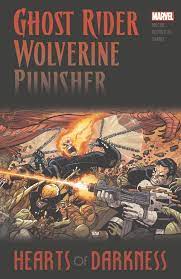 WOLVERINE / GHOST RIDER / PUNISHER: HEARTS OF DARKNESS
WOLVERINE / GHOST RIDER / PUNISHER: HEARTS OF DARKNESS
One-shot
by Howard Mackie, John Romita Jr, Klaus Janson & John Wellington
December 1991
Mephisto’s son Blackheart lures Wolverine, Ghost Rider and the Punisher to the small town of Christ’s Crown (where he was created in Daredevil #270). He offers them knowledge if they’ll help him fight Mephisto. In Wolverine’s case, he offers to reveal where his adamantium skeleton came from. Wolverine claims not to be interested, which obviously isn’t true – he’s about to spend most of a year investigating his past, over in his own book. But fair enough, he’s not desperate enough to strike a deal with a literal demon just to find out. Anyway, none of the antiheroes take the deal, so instead Blackheart tries holding an innocent girl, Lucy Crumm, hostage. That doesn’t work either, and the demon is defeated.
This is another Ghost Rider story with added guest stars, though it does have some wonderful art. A lot depends on whether you’re willing to accept the idea that asking Wolverine and the Punisher to fight Mephisto is somehow a good idea, but the story does try to sell it on the basis that antiheroes have the right combination of good and evil to be the greatest threat to him. It’s a stretch, but not completely outside normal parameters for magic stories… except that it feels so much like they started with the list of guest stars and worked back from there.
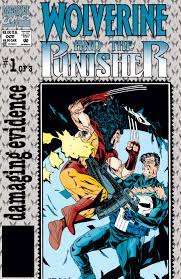 WOLVERINE & THE PUNISHER: DAMAGING EVIDENCE #1-3
WOLVERINE & THE PUNISHER: DAMAGING EVIDENCE #1-3
3-issue miniseries
by Carl Potts, Gary Erskine & Marie Javins
October to December 1993
The Kingpin (Wilson Fisk) has a new scheme to take out the Punisher, which involves a fake cyborg Punisher, Damage (Jaime Ortiz). Wolverine learns about this via a passing encounter with the Reavers, who supplied the cyborg technology. Kingpin’s self-explanatory henchman Sniper (Rich van Burian) is instructed to stop Wolverine interfering – much to his annoyance, because he really wants revenge on the Punisher himself. Meanwhile, assorted mind games aim to make the Punisher think he might have killed innocents during a blackout. Wolverine helps the Punisher to defeat the scheme, and we get a brief coda where Wolverine pretty much embraces the Punisher as a kindred spirit. (“We have similarities – treading an unsteady line in our quest to do good. It’s tough to balance instinct with intellect at times.”)
This story is notable mainly for Gary Erskine’s extremely off-model take on Wolverine, who has long flowing hair. It’s also another case of Wolverine being billed as co-star when he’s actually just cluttering up someone else’s story. He barely interacts with the Punisher, and the villains’ main agenda with him is to keep him out of the plot. The actual purpose of this miniseries was to tie up loose ends from Carl Potts’ Punisher War Journal run, which ended in 1990. The story expressly takes place before Daredevil vol 1 #297, which places it in 1991 continuity. It also references Hearts of Darkness as a past story, which means it can be pinned down quite nicely… except that it inexplicably also claims to take place before Uncanny X-Men #248. That’s totally impossible, as the Reavers are shown operating from Australia, so we’ll just ignore that bit.
NAMOR THE SUB-MARINER #21-25
“Call My Land K’un-Lun” / “Root of Evil” / “Like unto a Thing of Iron” / “Green War” / “She is Driven by a Force She Does Not Even Begin to Understand”
by John Byrne, Bob Wiacek & Glynis Oliver
December 1991 to April 1992
Drawn by instinct to an old house in New Jersey, Wolverine is captured by Plantman (Samuel Smithers) and Sssesthugar (a H’yltyri from the general vicinity of K’un-Lun). They brainwash him and send him against Namor, but when Sssesthugar turns on Plantman, Plantman retaliates by freeing Wolverine. Wolverine promptly kills Sssesthugar and a bunch of other H’ylthri before Master Khan teleports him away.
It’s another gratuitous appearance in a story that doesn’t need him, though at least here he’s relegated to a subplot. The main feature of this storyline is Iron Fist’s return from the dead, which Wolverine plays no part in.
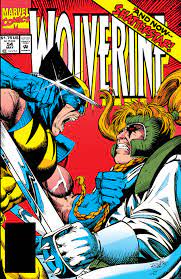 WOLVERINE vol 2 #54
WOLVERINE vol 2 #54
“Station Identification”
by Fabian Nicieza, Darick Robertson, Don Hudson & Kelly Corvese
May 1992
Wolverine and Shatterstar team up to deal with the Vidkids, a group who hunt Morlocks and film the attacks for their own amusement before posting them on the internet. No, just kidding. It’s the early nineties. They drop off the VHS tape with the local news.
But it’s the same plot. Wolverine is here for conventional heroic reasons; Shatterstar sees parallels with his homeworld’s arena fighting, and hopes to find a kindred spirit. He’s also overawed by Wolverine, who he insists on kneeling in front of and addressing as “Lord Wolverine”, “warrior of legend”. When the heroes do catch up with the Vidkids, Shatterstar quickly decides that they have no honour, and the heroes easily beat them. For his part, Wolverine has no interest in television (at its worst, he says, it’s an escape for people who don’t want to work at making their lives mean anything), and he’s left wondering whether Shatterstar is really capable of functioning as a normal person.
This is a fill-in story that appeared in the middle of a lengthy run of issues, and has to come out of sequence. It’s basically a Shatterstar story that tries to take his “MTV warrior” gimmick seriously and follow through its logic. As a piece of character development, it would have made more sense as a fill-in issue of X-Force, if it weren’t so far removed from that book’s normal style. But it’s ahead of its time in some ways, and it’s pretty good.
X-MEN ANNUAL vol 2 #1 (backup)
“The X-Men’s Top Ten Villains”
by Dan Slott, Karl Alstaetter, Scott Williams & Dana Moreshead
1992
A glorified featurette in which Wolverine uses the Danger Room to tell Jubilee about the X-Men’s top ten villains. Number one is hatred and fear. You get the idea.
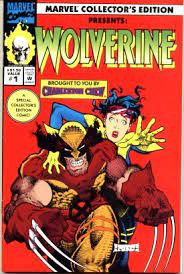 MARVEL COLLECTOR’S EDITION PRESENTS SPIDER-MAN #1
MARVEL COLLECTOR’S EDITION PRESENTS SPIDER-MAN #1
“Gimme a Break”
by Richard Howell, Larry Hama, Sam Kieth & Joe Rosas
Late 1992
Jubilee accidentally turns on the Danger Room at maximum threat capacity, and Wolverine rescues her.
This is a promotional giveaway anthology, and it’s basically a bonus issue of Marvel Comics Presents. Wolverine’s still in his brown costume here, which is why it’s placed before Wolverine #48. The script has Wolverine claiming to have broken a rib, which is… novel.
WOLVERINE: BLACK, WHITE & BLOOD #3
“32 Warriors and a Broken Heart”
by John Ridley & Jorge Fornés
February 2021
As revenge for Wolverine and Mariko’s interference with his criminal ambitions, the Silver Samurai kidnaps Amiko from her boarding school, and makes Wolverine and Mariko fight through 32 warriors to get them back. The last one is Amiko herself, embittered by their utter failure to actually parent her. Wolverine lets Amiko run him through with her sword and everyone leaves appropriately chastened.
While the general theme of Amiko being neglected by her “parents” comes up a lot, this is an odd one to fit into continuity, since it shows Mariko as an active sword fighter. But it can’t come after she returns from the dead as the Scarlet Samurai, because by that point (1) Amiko has become a teenager and changed her look, and (2) the Silver Samurai is either dead, or resurrected on Krakoa as an ally of the X-Men. So I’m sticking it here, in the latest possible slot when Wolverine is in the correct costume and Mariko is alive.
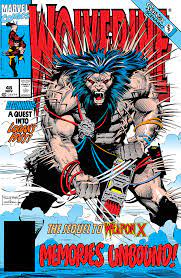 WOLVERINE vol 2 #48-49
WOLVERINE vol 2 #48-49
“Shiva Scenario, parts 1-2”
by Larry Hama, Marc Silvestri, Dan Green, Hillary Barta & Steve Buccellato
November & December 1991
Wolverine and Jubilee are led to the Weapon X facility by guide Harry Tabeshaw, who helped capture the Hunter in Darkness, and claims to have traced its lairs back to the facility’s location. As best as I can figure out, the connection between the Hunter and this site winds up being coincidental, and arises from the fact that there’s a supposed ancient burial site nearby (as mentioned in issue #52), which eventually turns out to be the burial site of a divergent Wolverine in a complex time travel story that also involves the Hunter. But we can worry about that later.
Wolverine finds the facility familiar, but can’t remember anything about it. He finds signs of claw marks, an old car that he somehow recognises (it’s the one he was driving at the start of “Weapon X”), and an old Indian pouch which presumably belonged to Sliver Fox. He also has outright flashbacks to the Weapon X Project, some of which are distorted by the “spike” imagery from earlier hallucinations. The flashbacks also include evidence that some of his memories are implants. Back at the Mansion, Professor X and Jean Grey help him explore his suppressed memories further, and we get weird hints about him and Creed encountering a revolutionary version of Silver Fox in 1960s Cuba. Despite the Professor’s warning that the process risks further mental damage, Wolverine persists, and manages to remember a mission (probably fictional) alongside Sabretooth and Mastodon.
As the scenes become increasingly surreal and confused, the telepaths pull him out, but Professor X worries that Wolverine has already suffered “considerable damage resulting in a possible reversion to a more antisocial state.” Wolverine rejects the claim, but not very convincingly, since he does so while tearing off his clothes, yelling that he’s a man and not an animal, and storming off. We’ll hear a lot of about this in the coming months before it fades out – among other things, it’s used to justify his return to the black and yellow costume.

[…] Next time, it’s 1991, and the new X-Men series is here. […]
I’d bet large sums that never in his life was George Orwell called “Ricky.”
Controversial opinion-
I prefer when artists draw Wolverine with more normal hair.
Hey Paul:
. . .and the Gold Team (Storm, Jean Grey, Archangel, Iceman, Iceman and Colossus)
An MCP from ‘91 featuring an early story by Dan Slott with early art by Joe Mad. I’ll be.
Thanks, John – sorted.
@Adam: the art is gorgeous and the story is cute for what it is.
This is the period when I took Wolverine most seriously at face value. For my money, at the time, Hama and Silvestri were on fire and putting our great, fun comics.
I’m a big fan of this era of X-Men.Terrific art from Lee and Silvestri particularly. It felt really exciting.
Claremont’s final storyline isn’t his best but it’s one I’ve got super fond memories of.
I tend to go off the books a lot once we hit about 1993 and heading into the endless crossovers/Scott Lobdell storylines that go absolutely nowhere.
X-Men #1-3 has flaws but you cannot fault Claremont for failing to leave material for future writers to build on, right to the end. We have Magneto’s heel turn, the introduction of the Acolytes and especially Fabian Cortez, the now-retroactively-important Moira stuff, and the start of the Rogue/Gambit romance. 30 years later, all of that remains relevant, which is pretty remarkable for what could’ve easily been a lazy paycheck story from an exiting writer.
I do find it funny, though, the number of entries where “Wolverine is in this story for no real reason” crops up is increasing rapidly. We’re definitely in the 90s. It strikes me that Spider-Man works better as the totally gratuitous guest star who is only there to boost sales since at a minimum, he’s the comic relief. When Wolverine is extraneous to a story, he’s really doing nothing at all.
Except, Magneto was supposed to be dead at the end of X-Men #3.
Claremont really didn’t want Magneto to be a villain. He dutifully played along with Harras, but there were enough subtle elements in the script to let the reader know Magneto wasn’t the real villain, it was Cortez.
Then, Claremont tried to kill Magneto to stop what writers would do to him the rest of the 1990s and through the Morrison run. Of course, it’s comic books, so that just immediately gets undone.
Claremont could rest easy knowing that the Real Magneto was dead and he never became a true villain again.
@Allan M: Spider-Man is a character with a well established past and a fairly stable personality. Also not a particularly aggressive one.
The role that Wolverine filled back in the 1990s in his own ongoing, in numerous guest appearances miniseries and one-shots and in his own ongoings in the self-named book and in MCP would not be a good fit for Spidey.
I literally just got the Elsie-Dee pun. GROAN!
Oh god, I just got it because you told me.
Ohhhhh… yeah, now I get it too. Thanks!
@Luis Dantas: I think Allan gets that the role Logan plays would not be a good fit for Spidey, but his point is that in the guest spots where he plays no role at all, but is just stuck in there because he sells books, Spidey, due to not being a violent beserker and alleged loner, would work better.
Oh, good grief, I’ve only just got the Elsie-Dee pun as well.
So that nobody else has to spend 5 minutes reading and re-reading the column to try to figure out the pun, as I did, Elsie-Dee = LCD.
The 1990s were heavy on promoting certain characters, often with very inconsequential roles.
As it happens, Wolverine was one of those. Spider-Man of course was also one of those, but only to a point. He was a hot property, but not a _new_ hot property.
To the best of my understanding, the idea was that the presence of the characters in crossovers and events would further the perception that both were significant and worth following.
It’s been well established that in the ’90s, because of how insanely popular Wolverine (and Spider-Man, Punisher, Ghost Rider early on, etc.) was, that whenever they appeared in someone else’s books, sales shot through the roof. Sales lagging on Nick Fury’s book? Stick Wolverine in it to boost sales. Want to make some money? Put out a Wolverine/Ghost Rider/Punisher special.
On the other hand, that may be true for characters like Sleepwalker, Darkhawk, etc. Having them appear in other, more popular books would (in theory) expose new readers to , and then maybe more people would go buy Sleepwalker (or whatever). Wolverine and the others didn’t need that kind of exposure, though. They were sales boosters.
On a different topic, I remember sending in for that Charleston Chew comic, being excited when it arrived, and then thinking “meh” after reading it. The Spider-Man story was also just OK. I still have that comic somewhere.
This era for Wolverine really is definitive, isn’t it? Larry Hama is still probably my favorite writer on the character. This pre-Image era had an energy that I don’t think has been matched since, but then I’m probably biased because this is when I had paper route money to spend on more comics and was really exposed to the wider Marvel Universe.
Also, I always loved it when Steve Lightle drew anything.
Larry Hama is when I got sick of Wolverine.
Everything became about the mystery of his background and memory implants.
Plus, I got so sick of the over-exposure.
I didn’t want to see Wolverine showing up in Namor and Dr. Strange.
My favourite period of Wolverine was the initial Claremont run on the Wolverine series.
[…] • 1991. Goodbye to Chris Claremont. Hello to Larry Hama. A very pleasant evening to Wolverine. […]
…a garbled, confused fashion filtered through movie tropes and so forth.
That was supposed to be a roast-style jab at Peter David’s writing but it turns out that fake HTML tags don’t work well here.
[…] Part 1: Origin to Origin II | Part 2: 1907 to 1914 Part 3: 1914 to 1939 | Part 4: World War II Part 5: The postwar era | Part 6: Team X Part 7: Post Team X | Part 8: Weapon X Part 9: Department H | Part 10: The Silver Age 1974-1975 | 1976 | 1977 | 1978 | 1979 1980 | 1981 | 1982 | 1983 | 1984 | 1985 1986 | 1987 | 1988 | 1989 | 1990 | 1991 […]
[…] • 1991. Goodbye to Chris Claremont. Hello to Larry Hama. A very pleasant evening to Wolverine. […]